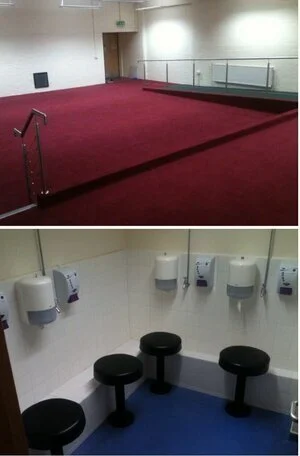The Challenges of Muslim Student Life Before the Prayer Room
Caption: The old prayer room during and after construction
For years, members of the ISoc had yearned for a Prayer Room, finding the lack of one to be detrimental to their spiritual and academic development. Certainly, as one student put it: “not having a Prayer Room meant no focal point for my social community, nowhere to practice my faith, nowhere to congregate to meet new people [or] to seek the company of fellow Muslim students.” Another told of the difficulties of having to pray in between library shelves, which often caught the unwanted attention of other students and caused much embarrassment. Adam Ali, the PR campaign co-ordinator, succinctly explained the value a PR would have: “It would be a priceless amenity for Muslim students in Oxford.”
‘Priceless.’ A very apt description of the insurmountable value of the PR. Before delving into the archives and hearing about a time before the PR, I don’t think I fully understood its significance to the society and its members. It’s where we gather several times a day to pray our Salah alongside our fellow believers. It’s where we congregate every night of Ramadan, to enjoin in the blessings and barakah of breaking our fasts together. It’s where we go to listen to the thought-provoking talks and discussions, which helps us learn more about our faith. The PR really is the focal point of ISoc, a spiritual haven and a retreat from the hectic and at times overwhelming life of an Oxford student. I’m sure many of us could not imagine life in Oxford without the home of our beloved society. It was truly enlightening to learn of the challenges faced by our predecessors in the years before the Prayer Room. Adam Ali mentioned the problems with arranging events and study circles before its establishment: “We used to have study circles in Christ Church College which wasn’t ideal - there was nowhere to do wudhu or to pray.” As mentioned by Liban, it allowed everybody to congregate for iftaar during Ramadan. It was surprising to hear that prior to 2012, daily iftaars would take place in the basement room of the Chemistry building and before that, in Magdalen College Old Court which, as one former student put it, was ‘basically a bar!’ Taraweeh would also take place at OCIS, which at the time was located on George Street. Taraweeh was one of very few prayers which students were permitted to pray in OCIS. So, for the usual 5 daily prayers, an alternative prayer room had to be found. Most of the options were down Cowley Road and this was extremely problematic for all the students who were not ‘blessed’ to be at St Hilda’s. Adam mentioned that ‘there was a small room in the middle of town, near where Kebab Kid and the Odeon Cinema are. It was the only type of Masjid in the whole city centre - just a small, hidden room.’
Katerina Nordin, a graduate student during the time, affirmed the significance of the Prayer Room’s establishment: ‘the Prayer Room gave me a place to retreat to. It was clean, private and very female friendly.’ This is a key point I feel cannot be overlooked - the PR’s establishment helped unite the ISoc by providing better provisions for the Muslim women, encouraging better engagement with the Muslim community.
Katerina continued to say that ‘It [the PR] really helped centralise the then, very disparate ISoc.’ ISoc had thus finally found a stable home. As mentioned in Surah An-Nahl, ‘Allah has made for you from your homes a place of rest.’ While the PR is not a home in the literal sense, it definitely qualifies as the home of our beloved society and to an extent our home away from home. The Prayer Room’s establishment finally removed the struggles of isolation and difficulty in connecting with one’s faith that so many students had faced, for far too long. It truly is a wonderful blessing from Allah.
Written by
Maryam Amer, OUISoc Alumni Officer 2020


